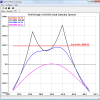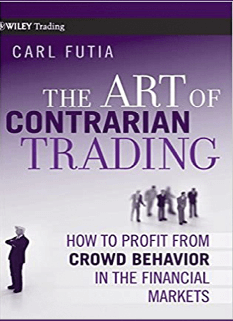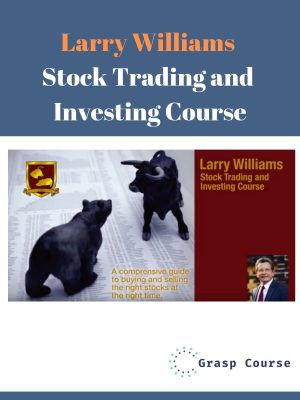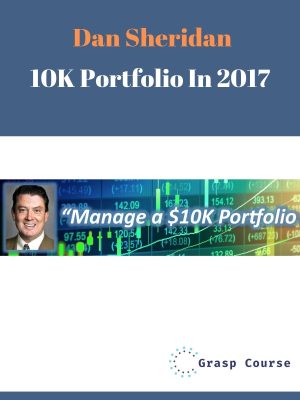Carl A.Futia – The Art of Contrarian Trading
$29.00
Why is it so hard to beat the market? How can you avoid getting caught in bubbles and crashes? You will find the answers in Carl Futia’s new book, The Art of Contrarian Trading. This book will teach you Futia’s novel method of contrarian trading from the ground up.
Carl A.Futia – The Art of Contrarian TradingDescriptionWhy is it so hard to beat the market? How can you avoid getting caught in bubbles and crashes? You will find the answers in Carl Futia’s new book, The Art of Contrarian Trading. This book will teach you Futia’s novel method of contrarian trading from the ground up. In 16 chapters filled with facts and many historical examples Futia explains the principles and practice of contrarian trading. Discover the Edge which separates winning speculators from the losers. Find out how to apply the No Free Lunch principle to identify profitable trading methods. Learn about the wisdom and the follies of investment crowds – and how crowds are formed by information cascades that drive stock prices too high or too low relative to fair value. Discover the power of your Media Diary – and how to use it to spot these information cascades, measure the strength of the crowd’s beliefs, and decide when the crowd’s view is about to be proven wrong. You will watch Futia apply these principles of contrarian trading to navigate safely and profitably through the last 26 tumultuous years of roller coaster swings in the U.S. stock market – a time during which Futia kept his own media diary and developed his Grand Strategy of Contrarian Trading. See how this Grand Strategy worked during the Great Bull Market of 1982-2000. Watch the Contrarian Rebalancing technique in practice during the dot.com crash of 2000-2002. Find out when the Aggressive Contrarian Trader bought and sold during the bull market of 2002-2007. Read about the causes of the Panic of 2008 and ups and downs of contrarian trading during that dangerous time. Futia shows you how the market turning points during the 1982-2008 period were foreshadowed by magazine covers and newspaper headlines that astonishingly and consistently encouraged investors to do the wrong thing at the wrong time. By monitoring crowd beliefs revealed by news media headlines – and with the guidance provided by the many historical examples Futia provides – a trader or investor will be well-equipped to anticipate and profit from market turning points. Table of ContentsPreface. CHAPTER 1 Can You Beat the Market? The Speculator’s Edge. Lending a Helping Hand to Investors. Uncovering Market Mistakes. Looking at the Evidence. Market Timing. Catch 22. CHAPTER 2 Market Mistakes. Efficient Markets. Roller Coasters and Stock Markets. Do Stock Prices Fluctuate Too Much? A Look at Behavioral Finance. Behavioral Finance and Exploitable Market Mistakes. No Free Lunch Redux. CHAPTER 3 The Edge. A Theory of Market Mistakes. To Get Along, Go Along. Go Along and Create a Mistake. The Social Calculus of Crowds. The Vision of a Contrarian Trader. CHAPTER 4 The Wisdom and Follies of Crowds. Can a Crowd Be Wiser Than Its Members? The Need for Collective Wisdom. Independent Decisions in the Financial Markets. Forecasting Market Psychology. Information Cascades into the Whirlpool of Speculation. CHAPTER 5 The Life Cycle and Psychology of an Investment Crowd. Prologue. The Cycle of Birth and Death. The Stock Market Bubble of 1994-2000. It’s Different This Time: The New Information Economy. Shattered Dreams: The Bear Crowd of 2001-2002. Popular Instincts and the Search for Certainty. The Pied Pipers of Investment Crowds. The Mental Unity of Investment Crowds. Suggestibility, Volatility, and Disintegration. CHAPTER 6 The Historical Context for Market Mistakes. Mature Investment Themes and Market Crowds. Mistakes versus Fair Value. Market Data Sources. The Deadly Mistake. When Is the Stock Market (Extremely) Overvalued? Download immediately Carl A.Futia – The Art of Contrarian Trading When is the Stock Market Undervalued? The Peak Oil Bubble. CHAPTER 7 How Crowds Communicate. What Do Information Cascades Tell Investors? The Role of the Mass Media. A Word about Personal Flexibility and the Future of Media. Monitoring the Markets. Studying the History of Bubbles and Crashes. CHAPTER 8 Constructing Your Media Diary. Gaining the Edge. How My Diary Made a Difference in 2002. Get Ready to Cut and Paste. Excerpts from My Media Diary: November 2005. Excerpts from My Media Diary: June 2006. Interpreting Magazine Covers. CHAPTER 9 Important Investment Themes. Telling the Market’s Story. New Eras. Effect of War and International Political Crises on the Stock Market. Financial Crises Create Crowds. New Industries and Companies. Commodity Booms. Interest Rate Movements and the Bond Market. Using Your Media Diary to Track Investment Themes. CHAPTER 10 Interpreting Your Diary: Market Semiotics. Media and Information Cascades. Your Media Diary: A Living History of Information Cascades. Semiotics: The Study of Signs. The Most Important Sign: The Price Chart. Magazine Cover Stories. Newspaper Headlines. Front Page Stories and Editorials. Crystallizing Events. The Weight of the Evidence. More on Market Semiotics. CHAPTER 11 The Grand Strategy of Contrarian Trading. Contrarian Investment Planning. Contrarian Trader’s Investment Portfolio. The Investment Goal of the Contrarian Trader. A Warning about Capital Gains Taxes. Contrarian Trading Strategy #1: Don’t Speculate. Contrarian Trading Strategy #2: Don’t Invest with the Crowd. Contrarian Trading Strategy #3: Contrarian Rebalancing. The Aggressive Contrarian. A Long-Only Strategy for the Aggressive Contrarian Trader. More Aggressive Contrarian Trading Strategies. CHAPTER 12 The Great Bull Market of 1982-2000. Prologue. The 1987 Crash. Interlude: The 1929-1932 Crash and Bear Market. The S&L Crisis, the 1987-1990 Bull Market, and the 1990 Bear Market Crowd. Rally without Joy, 1991-1994. The Stock Market Bubble Inflates, 1995-2000. The Aggressive Contrarian Faces the 1987 Crash. The 1990 Low. Long Term Capital Management Goes Bust. Chapter 13 Collapse of the Bubble: The 2000-2002 Bear Market. The End of the Great Bull Market. Contrarian Rebalancing during the 2000-2002 Bear Market. The Long Way Down Again. Contrarian Rebalancing during the Crash. The Aggressive Contrarian During the 2000-2002 Bear Market. A Wall Street Wreck. The Summer Rally. The March 2001 Plunge. Terrorists Attack on 9/11. End of a Bear Market. Transition to a New Bull Market. CHAPTER 14 The Postbubble Bull Market of 2002-2007. Escaping the Bear’s Claw What Bull? Looking for Signs of a Bullish Information Cascade. The Story of Google’s IPO. The Housing Bubble. Aggressive Contrarian Trading during the 2002-2007 Bull Market. April 2005—A Buying Opportunity. June 2006—Another Buying Opportunity. Aggressive Contrarian Trading in Early 2007. July-October 2007. CHAPTER 15 The Panic of 2008. The Conservative Contrarian during the Panic. The Mortgage Mess. The Debt-Deflation Spiral Takes Hold. Lenders of Last Resort. The Credit Crisis and the Contrarian Trader. Bull Market Top and the First Step Down. The Bear Stearns Failure. Fannie and Freddie. The Crash: Bankruptcy of Lehman Brothers. CHAPTER 16 Vignettes on Contrarian Thought and Practice. The Psychology of the Stock Market. The Godfather of Contrary Opinion. Opinion Polls: What Do You Think? Is The Odd Lotter Always Wrong? A Forecasting Giant of the Past. Paul Montgomery, The Magazine Cover Contrarian. Irrational Exuberance and Other Bubbles. Value Investing—A Back of the Envelope Approach. About the Author. Index. Author InformationCARL FUTIA is a trader who runs a highly rated investment/trading blog (carlfutia.blogspot.com). He provides very specific price forecasts for the stock, bond, and various commodity markets. Futia’s main tools are derived from the theory of contrary opinion and box theory. He holds a BA in economics from Yale University, a master’s degree in mathematics from the University of California at Berkeley, and a PhD in mathematical economics from Berkeley as well. Futia has published several papers in theoretical economics in scholarly journals. Forex Trading – Foreign Exchange Course Want to learn about Forex? Foreign exchange, or forex, is the conversion of one country’s currency into another. |
Be the first to review “Carl A.Futia – The Art of Contrarian Trading” Cancel reply
Related products
Stock Forex Options - Trading
Stock Forex Options - Trading
Stock Forex Options - Trading
Lex Van Dam – Million Dollar Trader + 5 Steps Trading Stock (BONUS)
Stock Forex Options - Trading
Stock Forex Options - Trading
Dan Sheridan – Butterflies for Monthly Income 2016 + Iron Condor Methodologies Trading
Stock Forex Options - Trading
Stock Forex Options - Trading
Stock Forex Options - Trading













Reviews
There are no reviews yet.